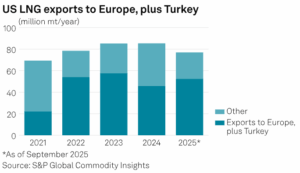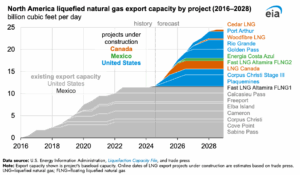Key Takeaways
The European Union has instituted a first-of-its-kind methane emissions regulation on imported fuels, providing significant uncertainty for the U.S. natural gas and LNG industry because details are yet to be defined regarding requirements.
Uncertainty about the implementation of the regulation has led European gas and LNG market participants to curtail some contract negotiations.
U.S. Energy Secretary Wright and key E.U. officials agree that changes need to be made.
How the methane regulation gets refined and implemented will determine the future of U.S. LNG flows to Europe and emissions reporting, which the Trump administration has taken steps to reduce while it focuses on expanding U.S. LNG exports.
In the U.S.-E.U. trade deal, the E.U. has agreed to buy $250 billion worth of U.S. energy per year for three years.
European Union (E.U.) officials are upholding a first-of-its-kind methane emissions regulation on imported fuels, creating significant uncertainty for the U.S. natural gas and liquified natural gas (LNG) industry. The regulation’s requirements have yet to be defined, and the regulation begins in 2027. According to S&P Global, uncertainty about the implementation of the E.U.’s methane regulation is already pushing European gas and LNG market participants to curtail some contract negotiations.
When it begins, the regulation will penalize importers of LNG into the E.U. who fail to prove that their gas meets the same monitoring, reporting, and verification standards imposed on E.U. producers. The E.U. requires importers to provide data “at the level of the producer,” which could be particularly challenging for American LNG exporters. As S&P Global explains, unlike most of the world, U.S. LNG export facilities source natural gas from a vast pipeline network. Supplies are commingled, including volumes sourced from different production basins with varied methane intensities.
According to the Oxford Institute for Energy Studies, the E.U. Methane Regulation, effective as of August 4, 2024, introduced new obligations for domestically produced and imported crude oil, natural gas, and coal, including accurately monitoring, reporting, and verifying upstream methane emissions.
The Trump administration, however, has taken steps to reduce reporting requirements while it focuses on expanding U.S. LNG exports. It has a proposal to end reporting obligations for oil and gas companies under the Environmental Protection Agency’s Greenhouse Gas Reporting Program.
After U.S. Energy Secretary Chris Wright critiqued a number of E.U. climate laws during his September visit to Europe, he indicated that E.U.’s legal regulatory framework had to change for U.S. natural gas to flow into Europe. According to Secretary Wright, there was agreement on both sides that the regulations as they are now written mean no more U.S. LNG would flow into Europe. Recently, the European Commission Director General for Energy, Ditte Juul Jorgensen, indicated that she was confident that Europe can implement its methane regulation “in a way that doesn’t constitute an irritant in any way.”
U.S.-E.U. Trade Deal
The United States and the E.U. have a preliminary trade deal that includes purchases of U.S. energy totaling $750 billion over three years. The E.U. has agreed to buy $250 billion worth of U.S. oil, natural gas, and nuclear fuels per year for three years. The strategic purchases include everything from spot purchases to long-term contracts for LNG and nuclear technology.
U.S. LNG Exports to E.U. and Export Capacity
Via S&P Global, the United States is the E.U.’s top LNG trade partner. In 2024, the United States supplied the E.U. with 36.6 million metric tons of LNG and the majority of U.S. LNG cargoes have been flowing to Europe since 2022.

According to the U.S. Energy Information Administration (EIA), the United States exported 11.9 billion cubic feet per day of LNG in 2024, remaining the world’s largest LNG exporter. The U.S. LNG export capacity is expected to double by the end of the decade as new export projects come online.
Via the EIA, on December 26, 2024, Plaquemines LNG — the eighth LNG export terminal in the United States — shipped its first cargo after achieving its first LNG production in mid-December. Plaquemines LNG is one of two U.S. LNG export terminals that started LNG production in 2024. Corpus Christi Stage 3, which is an expansion of the existing Corpus Christi LNG export terminal, also began LNG production in December 2024. LNG export capacity is expected to expand to 21.2 billion cubic feet per day by 2028 once the three other U.S. LNG export projects currently under construction — Golden Pass LNG, Rio Grande LNG, and Port Arthur LNG — are completed.

Analysis
While in the midst of natural gas shortages due to the Russian invasion of Ukraine, implementing such emissions regulations on imported fuels not only puts American suppliers in the crosshairs, but is a potential self-inflicted wound on Europe. Even as Europe moves to be free of Russian gas imports by 2027, by implementing new regulations on what will be American supplementation, Europe is demonstrating the catastrophic effect of extreme environmentalism. Instead of aligning with the emissions regulations of the foreign entities, including Qatar, that are looking to increase their exportation of natural gas to Europe, Europe seems to be disconnected from the real supply chain crisis that they face. If these regulations go into effect, it will have a detrimental effect on Europe’s ability to supply natural gas to its people.
For inquiries, please contact [email protected].



